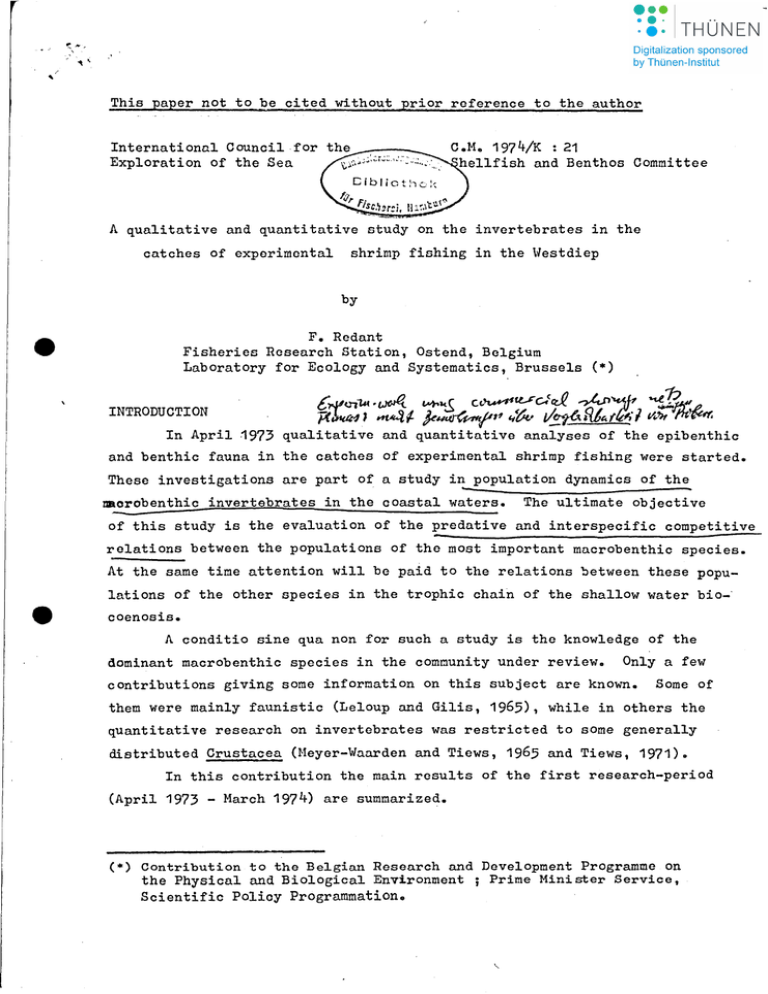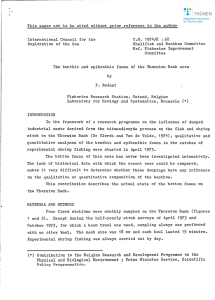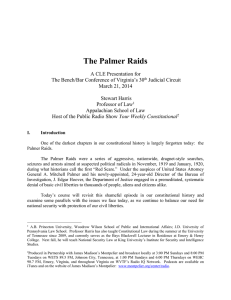Document 11829399
advertisement

This paper not to be cited without
~rior
reference to the author
C.M. 1974/K : 21
hellfish and Benthos Committee
International Councilfor
Exploration of the Sea
A qualitative and quantitative study on the invertebrat es in the
catches of experimental
shrimp fishing in the Westdiep
by
•
F. Redant
Fisheries Research Station, Ostend, Belgium
Laboratory for Ecology and Systematics, Brussels (*)
t"'1'1'o-i14t •~
c.+~ c~u.JCA(J. .."lvl"'1P ~'I#'.
INTRODUCTION
F<~1) ~t ~~l'tl 4~' &~Rt4t1;';1 f4,'Jr vffl{!u,.
In April 1973 qualitative and quantitative analyses of the epibenthic
and benthic fauna in the catches of experimental shrimp fis hing were started.
-
These investigations are part of a study in population dynamics of the
mlorobenthic invertebrates in the coastal waters.
The ultimate objective
of this study is the evaluation of the predative and interspecific competitive
relations between the populations of the most important macrobenthic species.
At the same time attention will be paid to the relations
~etween
these popu-
lations of the other species in the trophic chain of the shallow water bio-'
•
coenosis.
A conditio sine qua non for such a study is the knowledge of the
dominant macrobenthic species in the community under review.
Only a few
contributions giving some information on this sUbject are known.
Some of
them were mainly faunistic (Leloup and Gilis, 1965), while in others the
quantitative research on invertebrat es was restricted to some generally
distributed Crustacea (Heyer-Waarden and Tiews, 1965 and Tiews, 1971).
In this contribution the main results of the first research-period
(April 1973 - March 1974) are summarized.
(*)
Contribution to the Belgian Research and Development Programme on
the Physical and Biological Environment ; Prime Minister Service,
Scientific Polioy Programmation.
f
•
2.
MATERIAL AND METHODS.
Five fixod stations in tho Wostdiep were monthly sampled (figures
1 and 2).
The samplings wore mostly performed with an otter trawl.
Within
the framework of tho half-yoarly stock Gurveys of April and October 1973,
including the whole Bolgian coast and of which the Westdiep forms apart
(figure 1), a beam trawl was used.
Experimental fishing always took place
The mesh size of the net was 18 mm and each haullasted 15 minutes.
by day.
After grading the commorcial and non-commercial fishes, the catch
was washed down for impurities and divided into two fractions with a crabsieve.
The fraction romaining on the sieve contained the great by-catch species ; the
•
fraction falling through the sieve consisted of shrimps and small by-catch
From each fraction a sampIe Was tuken for analysis.
~ecies.
According to the
size and to the heterogeneity of the complete fractions, the volumetrie relation between sampIes and fractions varied from 1/1 to 1/30 for the sampIes
with the great by-catch species and from 1/1 to 1/20 for the sampIes with
shrimps and small by-eateh species.
The minimum volume of these sampIes was
respectively 3000 and 1000 ce.
Laboratory analyses of the sampIes involved determination of the
colleeted species, counting of the number of individuals per species and
measurement of the total wet-weight per species.
The planktonic Scyphozoa
and Ctenophora were not studied.
From the measured weights montBW mean densities for the whole area
tt
(in kg/hour fishing) were calculated for each species.
Yearly procentual
weight contributions (YWC) to the average total montBW catch were derived
from these data and are mentioned in table 1.
The months during which the different species were observed are also
noted in table 1.
This table givcs a qualitative picture of the seasonal
distribution of the species.
Monthly density data made it also possible to
add a quantitative interpretation of the seasonal distribution for some species.
RESULTS AND DISCUSSION.
The yearly mean weight of the catches was 84.2 kg/hour fishing.
From April 1973 till October 1973 the average weight of the catches showed
---,_ ...
.---- ....
_._.~
...-....
~ "'~
..
_-
-..-
a steady increase to a maximum of 206.2 kg/hour fishing.
From October 1973
the weight of the catches decreased sharply and reached a minimum of 12.4
kg/hour fishing in January 1974 (figure 3).
The following phyln, in order of importnnce (YWC-vnluos), were
%), Molluscn (YWC = 9.80 %),
Echinodermatn (YWC = 9.14 %), Coelpnterntn (n1C = 1.31 %), Bryozon (YWC =
1.01 %), Annelidn (n1C = .41 %) nnd Porifera (n1C = .006 %).
The most importnnt species (YWC
.1 %) were (tnble 1) : Mncropipus
holsatus (YWC = 40.06 %), Crangon crungo~ (YWC = 36079 %), frpia officinalis
(YWC = 9056 %), Asterjns rubens (YWC ~ 6.55 %), Ophiura texturata (YWC = 2 042 %)
observed (tnble 1)
= 78.31
Arthropoda (YV1C
Pagurus bernhardus (~1C
= 1.38
1025 %), Alcyonidium gelntinosum (n1C
•
0190 %), Psammechinus milinris (~1C
0105
=
%), Hydrozoa (considered us n whole : YWc
%) nnd Flustra folincea (n/c
= .720 %),
= .115 %),
=
Lanide conchilega (n/c
Aphrodite aculeutn (YWd =
= .105 %).
The high wcight contribution of Hydrozou (YWC = 1 25
0
caused by the nbundunce of this clnssis in April 19730
%)
was mainly
During the first
half-yearly stock survey lnrge qunntities of Hydrozoa were observed, especinlly
nlong the West coast (figure 4).
At this moment the catches of Hydrozoa in
the Westdiep were 6.8 kg/hour fishing on the average, which corresponds to a
procentual weight contribution of 16.8
%.
Probably these dense concentrntions
cnn be explained by the stormy wenther preceding the April-samplings.
It is
possible thnt the mnterial has been brought down from more Western nreas by
the dominant SW-NE coustnl current (Leloup und Gilis, 1963).
large qunntities of 1Izdrozoa were seldom fished (figure 5).
•
From May 1973
Consequently
Hydrozoa probably are mninly allochtonous in thc Westdiepo
Actinia equina, Naticn cutena,
Se~in
officinnlis, Sepiola atlantica,
Allotheutis subulata, Loligo vulgaris, Asterias rubens nnd Psammechinus
miliaris nre carnivores of n medium or n higher order (Bnrnes, 1968
1970 ; Jones, 1973 und Hewell, 1970).
of the catcheso
6.55
Sepia officinnlis (YWC
j
Hnrdy,
These carnivores represented 1707
= 9.56 %)
%
and Asterin rubens (YWC
=
%) were the most important of this group.
Sepin officinalis is n distinctly migratory species remnining only
in the constnl wntcrs during spnwning period (May-July).
After the repro-
duction period the spent males and femnles die while the nnimals who did
not take part in n copulntion lenve the constnl waters (Richard, 1971).
In the course of Muy und June 1973 (in July no sampling was perforoed) the
densities of Sepia officinulis reached respectively 6806 nnd 19.2 kg/hour
fishing on the average (figure 6).
64.9 and 17.7
% of
These
v~lues
correspond to respectively
the total catehes of these months.
As a matter of fact
in August and September only 0 yoar-old euttle-fishes were observed.
The smnller speeies Sepiola atlantica appeared in the catches in
quantities worth mentioning only during spring and summer (table 1).
more pelagie squids Allothoutis subulata und Loligo
ry speeies.
Consequently the
Cephalo~od~
v~lgaris
The
are also migrato-
do not belong to the permanent
endemie fauna of the Westdiep.
Apparently Aetinia oguinn, Natiea catena, Asterias rubons and
Psammechinus miliaris are the only invertebrate predators which can be con•
sidered as indigenouo in the Westdiep.
Aphrodite aculeata, Bueeinum undatum, Pandalus montagui, Crangon
erangon, Pontophilus trispinosis, Pagurus bernhardus, Maeropipus holsatus,
Carcinus maenas, Ophiura texturata and Echinocardium cordatum are omnivores
(Barnes, 1968 ; Jones, 1973 ; Newell, 1970 ; Plagmann, 1939 and Tait, 1968).
Same of these species like Aphrodite aeuleata, Crangon erangon and Hacropipus
holsatus playapart as detritophages and as carnivores of a lower or a medium
order (Barnes, 1968 ; Hardy, 1970 und Plagmann, 1939).
Other species, like
Pngurus bernhardus, Ophiura texturatn and Eehinocnrdium eordatum are mainly
detritophagous (Barnes, 1968 and Newell, 1970).
The yearly total procentual \'leighteontribution (Y\.,rC) of the omnivores
was 80.8
..
36.79
%)
%.
Macropipus holsatus (Y\VC
= 40.06
%) and Crangon erangon (y\1C
were the most important representatives of this group.
their repeatedly nummerous presenee Ophiura texturata (Y\.,rC
Pagurus bernhardus (Y\IC = 1.38
%)
=
In spite of
= 2.42 %)
and
were much less important in the eomposition
of the maerobenthie fauna.
An important eonelusion from these observations is that there exists a
great diserepancy between the observed numbers of earnivores und omnivores on
the one hand and the observed numbers of suspension and deposit feeders on the
other hand.
(
The main food-organisms- for invertebrate nnd vortebrate
earnivores,
_.
,._"'-"~';''''~'''
namely Annelida and Lamellibraehia, only constituted .47
% of
the catehes
(table 1 f.
The reason for this probably ean be found in the sampling method.
~-
The rigging of tho fishing goar doos the not glide ovar tho bottom as smooth-
ly as possible.
The penetration ofthe groundrope into the bottom is reduced
to a minimum by fastoning rolls to ito
A consequence of this might be that
the net would only take up the orcanisms living on or immediatly undcr thc
bottom surfacco
Moreover small organisms like most Polychaeta and Lamclli-
branchia havc a considerable chance to be washed out of the net during haulingo
The use of a shrimp not with a mcsh sizo of 18 mm as benthos-sampler, conscquently does not give enough guarantces for justificd quantitative investigations
on the population densities of smaller organismso
Yet the sampling method is appropriate for quantitative population
analyses of most
~hozoa,
some Polychaeta (f.eo Aphroditc aculcata), some
Gastropoda (foe. Buccinum undatum), Cephalopoda, Bryozoa, most Crustacea
~
Decapoda, Asteroidea, Ophiuroidea and most Echinoidea.
In order to follow the monthly evolution of the most important
autochtonous species, namely Crangon
crango~,
Macropipus hosatus, Pagurus
bernhardus, Asterias rubens and Ophiura texturata, monthly average procentual
wcight contributions (MWO) to thc total catches of indigenous spccies (= total
catch minus Hydrozoa and
Ccyhalopod~)
werG calcuLted for each month and for
each spccies (table 2)0
During summe3 and autumn (August 1973 - Decembcr 1973) Orangon
Macropipus holsatus dominated the macrobenthic fauna.
hc catches consisted of both these omnivore specicso
At least
During this
the carnivores and dctritophagcs only formcd aminority groupo
•
During
~pring
(April 1973 - June 1973) and winter (January 1974 -
March 1974) therc cxists a co-dominance between omnivores, detritophages
and carnivorcso
A dominant spccies can not bc indicatcd because Crangon
.
.
crangon, Macropipus hdsatus, Pagurus bernhardus,
~
,
~
~~~__
and Ophiura
texturata appear in variable concentrationso
f the catches
consistcd of these five spccieso
of Asterias
The
rubens during spring was smaller than during winter, but this was largcly
cornpensated by thc immigration of thc cqually carnivorc specics Sepia
officinalis.
CONCLUSIONSo
From the indigenous spccico that can bc otudied in a rcprcsentative
way by means of the oampling method used, Aphrodite aculenta, Alcyonidium
gelatinosum, Flustra foliacea,
Cran~on
crangon, Macropipus holsatus, Pagurus
bernhardus, Asterias rubens, Ophiura texturata and Psammechinus miliaris
take a more or less important part in the composition of the macrobeuthos
in the Westdiep.
The majority of the observed organisms are omnivores, detritophages
Or carnivores of a lower or a medium order.
In the trophic chain several of
these species form the link between the benthic epi- and infauna and the
demersal zooplankton on the one hand and the predatory fishes on the other.
BIBLIOGRAPHY.
Barnes, R.D. (1968) : Invertebrate zoology.
Ed. W.B. Suunders Oompany, London, 743 pp.
Hardy, Sir A. (1970) : The open sea.
Ed. Collins, London, 335
The world of plankton.
pp~
Jones, D.J. (1973) : Variation in the trophic structure and species composition
of some Invertebrate comminutios in polluted kelp forests in the
North Sea.
Marine Biology, XX, pp. 351-365.
Leloup, E. and Gilis, Oh. (1963) : La crevette dans le Sud-Est de la Mer du
Nord.
Ed. Zeewetenschappelijk Instituut, Oostende, 69 pp.
•
Leloup, E. and Gilis, Oh. (1965) : Zeedieren waargenomen in de experimentele
garnalenvangsten (1949-1964).
Ed. Ministry of AGrioulture, Commission T.W.O.Z., publ. nr. 1965/2,
26 pp.
Meyer-Waarden, P.F. and Tiews, K. (1965) : Der Beifang in den Fängen der
deutschen Garnelenfischerei in den Jahren 1954-1960.
Ber. Dt.Wiss.Komm.Meeresforsch., XVIII, 1, pp. 13-78.
Newell, R.O. (1970) : Biology of intertidnl animals.
Ed. Logos Press Limited, London, 555 pp.
Plagmann, J. (1939) : Ernährungsbiologie der Garnele (Orangon vulgaris, Fabr.)
Helgoländer Wisse Meeresunters., II, 1, pp. 113-162.
7.
Richard, A. (1971) : Contribution
a
l'etude experimentale de la croissance
et de la maturation sexuelle de Sepia officinalis L.
These de l'Universite de LilIe I.
Tait, R.V. (1968) :. Elements of marine ecology.
Ed. Butterworths, London, 272 pp.
Tiews, K. (1971) : Weitere Ergebnisse von Langzeitbeobachtungen über das
Auftreten von Beifangfischen und -krebsen in den Fängen der deutschen
Garnelenfischerei (1961-1967).
Arch.f.Fischereiwiss., XXII, 3, pp. 214~255 •
•
•
Table 1 - Yearly procentual weight contributions (YWC) to the average total
monthly catch of the species observcd in the Westdiep.
Distribution in time (*)
Species
Phylum PORIFERA
YltlC
· . x ••
.006
Phylum COELENTERATA (excl. Scyphozon)
1.310
x
Classis HYDROZOA
1.250
XX • XXXXXXXX
Tubulnria species
Laomedea spccies
Abietinaria abietina (L.)
Hydrallmania falcata (L.)
Sertularia species
•
X
X
X
X
X X X X X X X X X.·:X
•
X
X
X
•
•
•
•
•
•
0
X
X
X
•
•
X
X
X
X
XX
XXXXXX
X XXXX
XXXXXX
XXXXXX
0
•
•
•
0
Classis ANTHOZOA
.066
XXXXX • • XXXX
Actinia equina L.
Mctridium senile (L.)
.061
.005
X X X X X .. • X X X X
o
•
•
•
X
Phylum ANNELIDA
.410
XXXXX • XXXXX
Aphrodite aculcata (L.)
Lanice conGhilega (PalIas)
Pcctinaria koreni (Malmgren)
Other Annelida
.105
.190
.018
•100
X
X
X
•
X
Phylum MOLLUSCA
Classis GASTROPODA (**)
•
A M JAS 0 N D J F M
Natica catena (Da Costa)
Crepidula fornicatn (L.)
Buccinum undatum L.
Acanthodoris pilosa (O.F. Müller)
Classis LAMELLIBRANCHIA (**)
Mytilus edulis L.
Chlamys opcrcularis (L.)
Cardium edule L.
Vencrupis pullnstra (Montagu)
Spisula subtruncata (Da Costa)
Mactra corallina cinerea Montagu
Abra alba (W.Wood)
Angulus tenuis (Da Costa)
Angulus fabula (Gmelin)
Donax vittaltus (Da Costa)
9.800
0
XX
X
XX
XX
XX
0
.018
XX
1 d .001
.006
.011
1 d .001
X •
.062
• 013
1 d .001
•004
1 d .001
1d .001
• 027
1 d .001
.005
.001
.012
Classis CEPHALOPODA
9.720
Sepia officinalis L.
Sepiola atlantica d'Orbigny
Loligo vulgaris Lamarck
Allotheutis subulata (L.)
9.560
.044
.026
.087
X
X
X
X
X
0
•
•
•
•
X
•
9
•
0
• • XX
XXX •
• X • •
X • •
XXXX
0
X
•
..
•
X
ooXXXXX
•
0
• X
o
•
X
•
X
X
0
0
0
e
000
o
0
o
0
•
0
0
X • XXX
0
•
• • X
• X • X •
XXXXX • XXXX •
•
eoooe
• X • • • X • X •
·· .. .· .• X • . .. ..
..
X . . .
• X • X • • • • X .. •
•
o
0
0
0
X
o
0
0
o
X
0
•
0
0
0
•
0
0
X
•• XXX ... oXoo
•
0
0
• • X.
•
0
•
000
G
••••••
X • XX • • • •
0
00.
XXXXXX • • XXX
o
XXXX •
• X XXX
o
0
X X •••
XXXXXX
o
•
•
•
•
• X •
•
0
•
0
o
0
•
X·-X
•
>
9.
Table 1 (continued)
Distribution in time (*)
Species
YWC
Phylum BRYOZOA
1.010
Alcyonidium gelatinosum (Lo)
Alcyonidium polyoum (Hassall)
Flustra foliacea (L.)
Other Bryozoa
•
x
XXXXXXXXXX
.720
1d .001
.105
.185
78 .. 310
X X
X
XX
0
XX
Ordo Cumacea
1d .001
.0.
Ordo Isopoda
Idotea linearis (L.)
Idotea balthica (Pallas)
.001
.. 001
1d .. 001
Phylum ARTHROPODA
Classis CRUSTACEA
Ordo Amphipoda
•
A M JAS 0 N D J F M
Ordo Decapoda
Pandalus montagui Leach
Hippolyte varians Leach
Processa canaliculata Leach
Crangon crangon (L.)
Pontophilus trispinosus (Hailstone)
Pagurus bernhardus (L.) (**)
Porcellana longicornis (L.)
Macropipus holsatus (Fabricius)
Carcinus maenas (L.)
Pinnotheres pisum (Pennant)
Macropodia rostrata (L.)
·
·
X
0
X
X
X
X XXX
0
•
0 .
XX • X
XXXX
.·
·.
•
0
X
X
X
•
X
X
0
X
•
X
XX
X
XX
X •
XX
.
· .XX
X •• o.o.XXX.
X
0
0
000
0
0
0
0
•
0
0
0
0
XX
X •
0
0
0
.005
XX • X • • XXXX 0
78.300
0017
XXXXXXXXXXX
XXXXXX XX • 0 0
1 d .001
o . X . X . o o o oo
.001
36.790
.001
1.380
1 d .001
40.060
.011
Phylum ECHINODERMATA
9.140
• • X 0 • .. X X 0 • •
XXXXXXXXXXX
XXXXX •• XX.o
XXXXXXXXXXX
X .. .. • X • X •
XXXXXXXXXXX
o
X
X
o
X
XXX XXX • X XXX
X XXXXXXXXXX
Classis ASTEROIDEA
6.550
XXXXXXXXXXX
Asterias rubens (Lo)
6.550
XXXXXXXXXXX
Classis OPHIUROIDEA
20420
XXXXXXX XXXX
Ophiura texturata
2.420
XXXXXXXXXXX
La~arck
1 d .001
0033
Classis ECHINOIDEA
.180
Psammechinus miliaris (Gmelin)
Echinocardium cordatum (Pennant)
.115
.062
..
0
0
0
0
•
0
•
0
0
0
0
0
0
0
•
0
X XXX • • XXX
.. X X X • • X • ..
0
0
0
0
0
X
X
Xo . . . . . . XX .. X
The YWC-values larger than .1 were rounded off to the nearest .005
larger than 10 were rounded off to tho nearest .01.
1d .001 = loss than .001 %.
(*) : Months during which thc different species were observed
no sampling was performed.
(**) : Weight contributions including shell ..
(X) ..
the values
In July 1973
Tnble 2 - Monthly average procentual weight-contributions (MWC) of the most important
specieso
Species
/
Month
IV
V
VI
VIII
IX
X
XI
XII
I
II
III
80.0. 69.9 6306 93 02 9702 9809 92 05 9302 4206 6603 5508
5300 1306 802 601 7105 5109 4904 6209 2708 50.4 48.7
Crangon crangon
4.8 2.7 300
.2
.1 , ..2.0
.3
1.2 603 5.9
Pagurus bernhardus
·3
909 1302 400
Macropipus holsatus 2601 4908 4901 8607 2504 4608 4101 3000
Crustacea Decapoda
Echinodermata
Asterias rubens
Ophiura texturata
1605 2603 3400
906 1802 26.1
607 608 7.9
409
3.1
107
1.2
.8
04
.6
01
05
608
401
204
206 4506
106 3803
4.8
06
28.5 40 07
25.5 2605
300 1306
-\,
o
•
..
' I. •
',.
','
'1
•
:
,.
".
. '"
:
.,'
"
,
,
•.
•
""
'
~
•
•
•
• •
..
•
•
.
-
•
-
..
•
....
•
•
.. .-
'.
'• .
• ..
:
•
"
,...
.. .
•
.*24
* *23'
.
"
j
Westdiep sampJ.ing.:stations
Stations half-yearJ.y surveys
25
--------------_._-._--_._ __...... _--------_.Z030'
..,.
i
Z'45'
....
.
3'00'
_
._-.. _-- .. .•......
. 3°15'
j
I\
3'30'
I
Figure·l. Positions or the sampJ.lng stations aJ.ong the coast.
,:'1
,
I
t'
I
.......
. ~,.
-,
,-
I
ri
16
II
. 1 km
I
~
....
'"
.... ,
51'01'30"
Position~
,,,,..
0'
I
I' •
---
. . -'.
I:'
•
,'!
·.~amp11ng
.'
_I.
,.
,.'
"
'.
;"
,I
I
of the Weatdiep
,stations.
Depthsin
deoimetres.
. i.,•
\
'",
I
I
F:i.gure '2.
':
,I
','
.'
..
..
kg/hour fis hing
200
...
180
.~ Echinodermata
.'
"
I
.1I
•
160
m
D
Other Crustacea
G
Macropipus ho1satl1s
~
.....
.....
.....
140
120
m
Crangon crangon'
.....
.....
Cepha1opoda
rJ
Other groups
..
:,:::,-",
100
m
•
80
c
60
40
m
20
c
.....
.....
.....
.....
.....
.....
.....
.....
.....
.....
.....
.....
.....
.....
.....
•..•.
.....
.....
.....
.....
.....
•.•..
...••
•.•..
.....
.....
.....
.....
.....
.....
.....
.....
.....
.•..•
.....
.•...
.....
.....
.....
.....
.....
m
c
c
m
m
m
c
..... .....
.......
....
.....
....
.
....
.....
.....
.....
.....
....
..... ......
.....
.....
..... .....
.....
.
c
'! • • • •
IV
V
VI
VIII
IX
X
XI
XII
I
.
11
1973 1974
Figure
3. Evolution and composition of the catches in the Westdiep.
111
. ..
•
','
.
',-"
",
~
,
"'.
'
.
<,
:.
•
.
•
.'
•
o
Period
24:.04.73
~.-
,'.
6
5
i~
. ~:
3
2
I
1
I
I'i
...
...
...
...
.........
...
...
............
...
...
...
...
...
...
...
...
...
...
...
...
...
...
...
...
...
...
...
...
...
...
...
.........
...
......
....................
... ..
I
;
03.05~73
101-500 ( )
.
·70
:~
';,
,.;"
5':<
Figura
'.
;
.,.
:
'.
60
~
50
,.
'.
. '.
40
30
"
20
.,.
...
...
...
...
............
0::
IV V VI VII VIII IX X. XI XII I· " '111
1973 '1974
,,,-~,,.-., "'.~~
....
"
........
3'30'
~
kg/hour fishing
;
.:
•
0
51-100
__
_-~
:'-.<
.7
•
6-20
21-50
3'00' ..
_ _.- Z'4S'---_ ..--._-_._--_.....
.. _.
3'15'
2
Distribution and' density (gr~lOOO m ) of Hydrozoa.
Figure 4,~.
Z'JO'
••
~5
.'."
e'
•
\J
•
•
._--- __..
••
r"\.:
.... ••
• • • .0o·
• •
on
.
••
..
':,
~
"
l'
"
.
•
• ••
.,
~___
..
"
"
'.
.......•..
...
...
...'......
...
<Figura 6 ..
.....
...
....
...
.. ..
.....
...
...........
....
.....
.......
....
...
.......
............
....
.....
...........
...
.
...
...
.....
..... ...
....
..
.
...
...
...............
.. . .......
... .....
...
.. ... .
.'.
I
{/ I
I
0::
10
co.
E
I
<::>
I
0::
IV V VI VII VIII IX
X XI XII
I
"
111
'1973
197~
Abundance of,Hydrozoa(left) and Cephalopoda (right) in theWestdiep •.
~ 1.
d
';j
!l
,,'
,T
I
I
'1
II
'1


